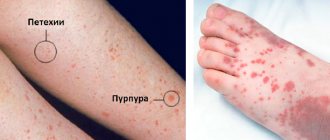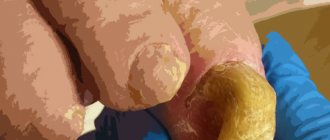Causes of the pathological condition
Among the main reasons for the lack of taste and smell are:
- Acute respiratory viral infections, including Covid-19. With such diseases, swelling of the mucous membrane of the nasal and oral cavities occurs, which leads to loss of sensitivity of receptor cells. On average, the symptom occurs on days 3-5 of illness, while other clinical manifestations may be absent. Most often, approximately 2-3 weeks after recovery, functions are completely restored, but in rare cases, a longer loss of taste and smell, as well as their perversion, is possible. This outcome is most often observed in patients who have suffered coronavirus infection.
- Alzheimer's and Parkinson's disease. In a large number of cases, the symptom in question is the earliest sign of upcoming pathological changes in the central nervous system. In such conditions, loss of taste and smell has only a neurological origin. Dystrophic and degenerative processes in the brain primarily affect the olfactory cortex and some other structures, which leads not only to loss of smell, but also to disturbances of attention, memory and coordination.
- Allergy. The pathogenesis of symptom development is similar to infectious diseases. Swelling develops in the mucous membrane, which interferes with the normal perception of aromas and tastes.
- Traumatic brain injuries (concussions, bruises, fractures).
- Malignant and benign neoplasms of the brain, mouth and nose.
- Chemical and thermal burns. Damage to the mucous membrane leads to the death of sensitive cells and, as a consequence, loss of taste and smell.
- Deviation of the nasal septum.
- Hypo- and vitamin deficiency (especially vitamin A deficiency).
- Smoking. Regular intake of nicotine into the body has a detrimental effect on the receptors, which leads to a gradual decrease or even complete loss of smell and taste.
- Age. In old people and elderly people, atrophy of sensitive cells develops, resulting in an unpleasant symptom.
Survey
Patients with complaints of loss of smell more often consult an otolaryngologist. Since anosmia can be associated with both damage to the upper respiratory tract and brain pathology, a comprehensive diagnosis is carried out. The examination plan includes functional tests, instrumental and laboratory tests, which are aimed at determining the degree of decrease in olfactory sensitivity and identifying the root cause of the symptom. In diagnostic terms, the most informative are:
- Olfactometry.
A qualitative assessment of the ability to distinguish aromas is carried out using a special device - an olfactometer. Using test tubes with different strong odors in combination with performing tests alternately for both nasal passages allows you to detect one- or two-sided reduction in odor perception. Loss of smell on one side is of great diagnostic importance. - ENT examination
. An examination of the paranasal sinuses and upper respiratory tract is carried out to exclude the rhinogenic nature of olfactory disorders. During rhinoscopy, the mucous membrane of the nasal cavity is studied in detail. If purulent discharge is detected, it is collected for further examination. An “adrenaline test” is done to differentiate between catarrhal and hypertrophic rhinitis. - Instrumental inspection
. The standard method is radiography of the skull bones, which is prescribed if traumatic damage to nerve structures is suspected. To exclude sinusitis, X-ray images of the paranasal sinuses are shown. For neurological diseases, a more accurate method is computed tomography; in some cases, MRI of the brain is prescribed. - Laboratory examination
. Nonspecific signs of inflammatory processes are detected using general and biochemical blood tests. If there is nasal discharge, bacteriological culture is performed. Specific, highly sensitive blood tests for toxins and narcotic substances help eliminate poisoning as the cause of loss of smell perception.
After eliminating organic prerequisites for anosmia and physiological age-related changes in the receptor apparatus, additional examination methods are prescribed according to indications - allergy tests, angiography of cerebral vessels. In case of possible functional disorders of smell caused by disturbances in the emotional sphere, consultation with a neurologist or psychiatrist is necessary.
Nasal endoscopy
Lost sense of smell and taste: what to do
Ways to restore sensitivity:
- Surgical. Surgical intervention is required when malignant and benign neoplasms are detected in patients (polyps, oncological processes), as well as when changes in the structure of the nasal cavity (deviated septum).
- Medication. Drug treatment is prescribed to patients with allergic and infectious processes. Antiviral, antibacterial and antihistamine drugs are used for therapy.
- Physiotherapeutic. To restore the sense of smell and taste, patients are prescribed inhalations, heating and laser exposure.
Restoration of sensory functions can occur in some cases without treatment, that is, on its own. However, if a symptom occurs, you should not rely on chance and it is recommended to consult a specialist to determine the cause of the phenomenon and prescribe adequate therapy.
Various traditional methods are also used for treatment. However, they should not be used in isolation, but only in combination with medical prescriptions and after consultation with the doctor. Most often, nasal rinsing is used with a decoction of oak bark, chamomile flowers, as well as nasal drops based on aloe juice.
Restoring the sense of smell
If you have a long-term loss of smell, you should immediately go to the clinic for an appointment with an otolaryngologist. If you treat yourself, you can worsen the current condition.
Recovery can be:
- Surgical.
Such intervention may be required in advanced cases (for example, with a tumor or deviated septum). Then the surgeon performs the operation.
- Medicinal.
The doctor prescribes a list of necessary medications, from nasal rinses to antibiotics, antiviral and antifungal agents.
- Physiotherapeutic.
Treatment may require physical therapy. The doctor prescribes heating or inhalation, and in some cases laser treatment is performed.
- People's
No one has abolished traditional medicine, but in no case should you prescribe decoctions for yourself. The doctor may prescribe a decoction for rinsing the nose from chamomile and oak bark or nasal drops based on aloe juice.
- Complex.
Those. This is the application of all types from physical therapy to surgical.
Methods for treating smell disorders
- rinsing the nose with saline solutions;
- use of hormonal-based sprays to relieve inflammation and swelling (strictly as prescribed by a doctor);
- olfactory training with essential oils.
It should be noted that scientists have not been able to establish a relationship between the use of these products and the restoration of the sense of smell, that is, the effectiveness of these treatment methods for impaired smell in COVID-19 has not been proven. Olfactory training with essential oils can be recommended for those whose sense of smell has been partially restored, but not in cases where the perception of smells has been distorted or other disturbances have occurred. The evidence base for the effectiveness of olfactory training for smell disorders after Covid-19 is weak.
Unilateral anosmia, bilateral – symptoms
Impaired sense of smell can be combined with the following symptoms:
- memory problems;
- double vision;
- difficulty swallowing;
- speech problems;
- runny nose;
- cough;
- general weakness, etc.
A different combination of symptoms helps the doctor differentiate peripheral (impairments at the level of olfactory receptors and nerve fibers) anosmia from central (associated with brain damage at the level of the olfactory center).
In order to distinguish unilateral from bilateral loss of smell, the doctor performs a special test. The otolaryngologist alternately brings substances with a strong odor (vanilla, coffee, etc.) to one or the other nostril. A special olfactory test kit may also be used.
Diagnosis of anosmia
At the appointment, the otorhinolaryngologist clarifies a detailed history of the disease. It is important to provide information as completely as possible to exclude factors such as head injury, smoking, medication, chronic diseases, etc. The doctor will also examine the nasal cavity using a special instrument called a video endoscope to see if a polyp or other growth is affecting the sense of smell.
Additional tests and examinations, such as computed tomography or magnetic resonance imaging, may be needed to determine the cause of anosmia.
1.General information
The term “anosmia” is translated from ancient Greek as “lack of odors”, i.e. loss of smell. This collective concept summarizes etiologically and clinically heterogeneous conditions in which olfactory sensitivity is completely absent or sharply reduced; for the second case, the narrower terms “hyposmia” or “microsmia” are also provided.
As is known, the ability to detect, distinguish, and identify odors is one of the five basic perceptual functions that ensure human adaptation to external conditions. The loss of any of the five senses is a serious medical and social problem, significantly limiting the quality of life, and in some cases acting as the first symptom of a developing severe pathology.
There are no exact epidemiological data regarding anosmia, since in medical and statistical records this nosological unit is most often absorbed by more general diseases or syndromes, within which it is registered as one of the complications. Most sources classify anosmia as a rare type of pathology, which is disputed by some modern publications, according to which anosmia and especially hyposmia are much more common than previously thought.
A must read! Help with treatment and hospitalization!
Features of loss of smell due to coronavirus
What complaint do you think is one of the most common with coronavirus? According to research, this is a loss of smell and taste (ageusia), affecting 3/4 of all sick patients to varying degrees. I note that sometimes this is the most striking, only and lasting symptom. The frequency of anosmia with coronavirus is so high that it is proposed to consider it an indicator of coronavirus at the level of PCR smear analysis. In practice, there are cases when patients become depressed due to six-month anosmia, because imagining a morning without the aroma of freshly brewed coffee or not feeling the taste of food prepared by a loving person is equal to the 4th circle of suffering according to Dante, and no less.
A ray of light in this dark kingdom is the fact that, as a rule, the sense of smell returns in the first month for over 90% of lucky people. It's all about the particularity of the coronavirus damaging ACE2 (angiotensin-converting) and CD147 receptors that support olfactory cells (horizontal basal cells) - roughly speaking, the virus does not affect the receptor itself and the olfactory nerve, but the cells from which new receptor cells are formed to replace the old ones . Thus, there is no renewal of nerve endings - and, as we know, neurogenesis is a very slow process. Fortunately, the olfactory nerve endings are updated from several sources. It is noteworthy that in young people the level of ACE2 proteins is lower than in older people - this may be due to the more aggressive course of LE in the latter. The peculiarity of the loss of smell with CV, unlike other viruses, is that with it there is practically no nasal congestion and discharge from it.
On what day does anosmia appear with coronavirus?
Approximately every 2-3rd patient with Covid experiences anosmia. Usually this symptom appears at the beginning of the disease. Often combined with ageusia.
How long does anosmia last after Covid?
It is generally accepted that this is a temporary condition with a short duration. However, recently there are more and more reports that smell disturbances can persist for quite a long time.
How does our sense of smell work?
Deep in the nasal cavity, millions of sensory neurons are located in tissue called the olfactory epithelium. The tips of these cells contain proteins called receptors that bind odor molecules. Receptors are like locks, and passing odor molecules are like keys. Humans have about 450 different types of olfactory receptors. (For comparison, dogs have about twice as many.)
The complexity of receptors and their interactions with odor molecules is what allows us to detect a wide variety of odors. And what we think of as a single smell is actually a combination of many molecules acting on many receptors, creating a complex neural code that we can identify as the smell of a rose or freshly cut grass.
This neural code begins with the olfactory sensory receptors in the nose. Once an odor molecule binds to a receptor, it initiates an electrical signal that travels from sensory neurons to the olfactory bulb, a structure at the base of the forebrain that transmits the signal to other areas of the brain for further processing.
Symptoms of a sense of smell disorder occur when one of the links in this chain is affected. This may be a malfunction of the olfactory sensory receptors or the part of the brain responsible for smell.
Why don’t everyone who recover from coronavirus infection lose their sense of smell?
Anosmia usually develops on days 4–6 of illness.
By 10–14 days, most people have recovered and the ability to distinguish aromas returns. But for some, the defect remains. You need to understand that any disease cannot occur in the same way in different people. No two organisms are identical, and accordingly, diseases will progress differently. Other significant factors:
- Viral load is the number of microbes that have entered the body. The more, the more severe the disease.
- The virulence of a virus is the strength of its destructive (damaging) effect. Different types and subtypes of coronaviruses vary. Don't forget that viruses mutate and change.
- Immune memory. The more acute respiratory viral infections a person has suffered in his life, the more easily he suffers from coronavirus, the lower the risk of complications.
- Concomitant human diseases: diabetes mellitus, obesity, severe forms of hypertension, respiratory failure. And if these diseases are combined, coronavirus infection is even more severe.
4.Treatment
In some cases, anosmia is transient - the sense of smell is spontaneously restored upon completion of the action of the causative factor (such, for example, are many cases of toxic, mechanical, hysterical anosmia). Other forms today remain irreversible and incurable, in particular, idiopathic, congenital or atrophic anosmia. With congenital anosmia, there is a theoretical possibility of (neuro)surgical reconstructive surgery, but such interventions can only be performed in early childhood (up to three to four years) and in practice are carried out extremely rarely, only when absolutely necessary and in the presence of additional indications, since the risk is unacceptable high, and the results are not predictable enough.
In other cases, the prognosis of anosmia directly depends on the success of curing the underlying disease (chronic infection, neuritis, etc.) or eliminating the causes that caused it (removal of polyps, vascular aneurysms, polypous growths).
What diseases does it occur in?
Often, loss of smell accompanies the course of acute respiratory viral infections and acute respiratory infections. At the same time, the nasal mucosa swells, making it difficult for patients to breathe. If you remove the congestion, sensitivity will be restored. The same mechanism of loss of smell is characteristic of allergic rhinitis and sinusitis.
Much more people are concerned about why the nose breathes and odors are not felt. This happens when nerve fibers or receptors are damaged. The symptom occurs with chronic atrophic rhinitis, uncontrolled use of vasoconstrictor drops for the common cold, taking ACE inhibitors or estrogens, as well as heavy metal poisoning. This is also observed with influenza and coronavirus infection.
Damage to the areas of the brain responsible for smell is quite rare. This happens with degenerative pathologies of the nervous system (Alzheimer’s disease, multiple sclerosis), head injuries, and also against the background of complications after brain surgery.
Olfaction: the mechanism of sensitivity to odors
A group of sensitive cells that are located in the superior turbinate and the adjacent area of the nasal septum . Molecules of substances from the inhaled air, dissolved in nasal mucus, fall on the cilia of these cells. A separate pair of cranial nerves is responsible for carrying signals from such receptor cells to the brain.
The complete loss of the ability to smell is called " anosmia ". If this ability is weakened, then the condition is called " hyposmia ". The sense of smell may become less acute if a strong odor is present for a long enough time - adaptation to the smell occurs. Restoration of high sensitivity of smell occurs seconds or minutes after the cessation of exposure to the smell. As you get older, your sense of smell may become slightly dull. Women tend to be more sensitive to odors than men.









